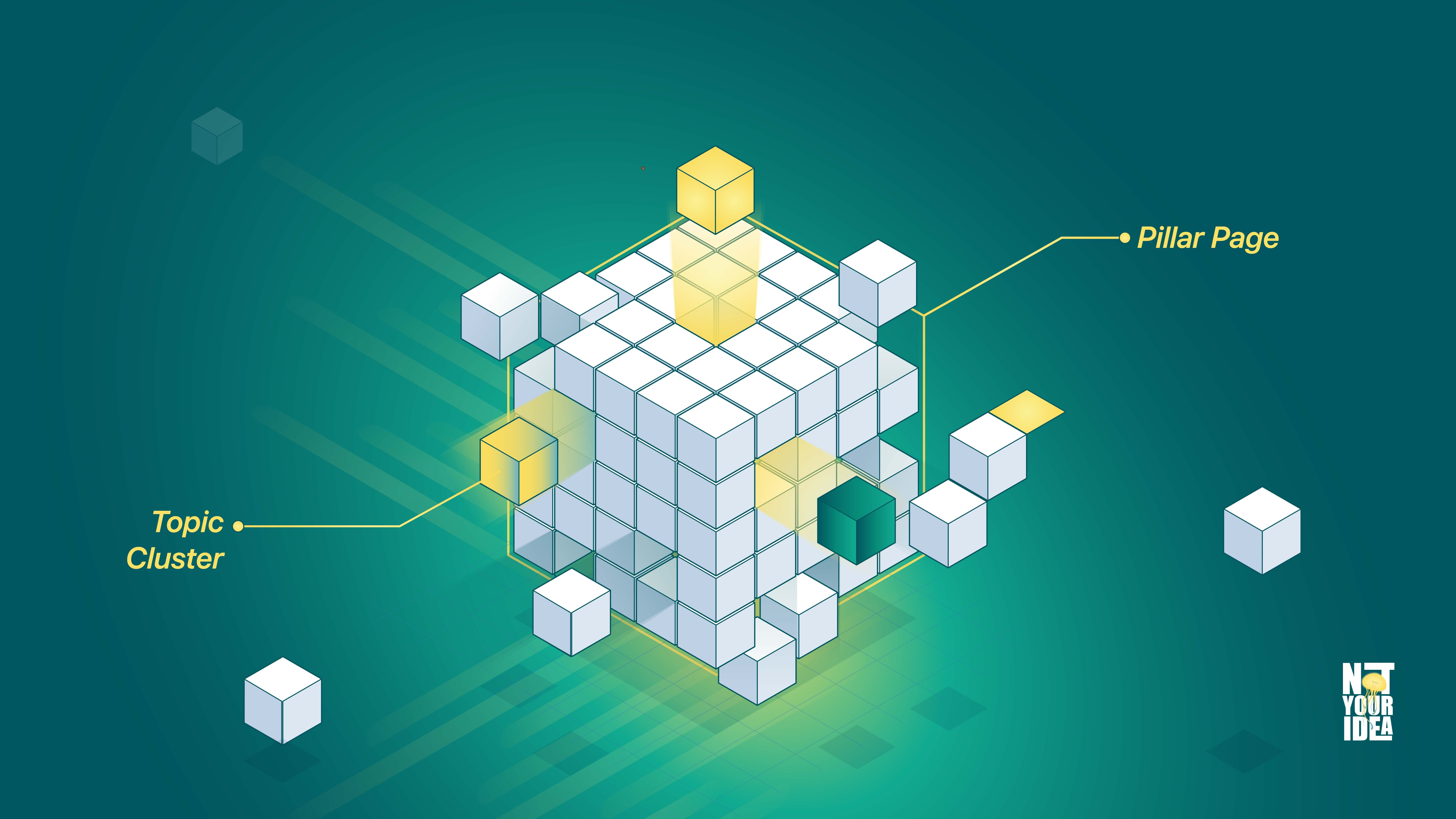There’s no denying that the SEO playbook is changing rapidly, and marketers are scrambling to decode what remains relevant and what becomes outdated. Amidst this chaos, we’re tackling an SEO tactic that’s sure to last. Here’s why you should double down on structured content that users, search engines, and AI systems recognize as authoritative, comprehensive, and worth reading.
What Are Pillar Pages and Topic Clusters?
Pillar pages are comprehensive content hubs that cover certain broad topics in detail. These hubs connect to more specific, related subtopics known as cluster content. Together, the cluster content forms a network of related topics, with each piece linking back to the pillar page and to other relevant cluster content when appropriate.
Think of it this way: you have one blog simply titled ‘SEO - Search Engine Optimization’. This blog covers all the basics, but each section contains a link to a blog that covers that subpoint in detail. So, the pillar content will branch out to topic clusters like ‘How is SEO changing?’, ‘What are the types of SEO?’, ‘SEO updates for 2025’, and so on.
An element of on-page SEO, this interconnected structure helps search engines understand both the depth and breadth of your content expertise. It signals clear authority on the subject, reduces content duplication, and increases overall topical relevance. It also makes it easier for people to find a wealth of information, neatly chunked and connected together for them to navigate.
How It Works
Traditional SEO focuses on creating individual posts optimized for specific keywords, which has its perks but also has its shortcomings. For one, even though the blogs could be part of a larger content strategy, it often leads to disorganized content being published. It risks content cannibalization since multiple keywords could be competing against each other at some point. The information often begins and ends on the same page, leaving visitors stranded if they want to find more related information.
Topic clusters solve these issues by organizing related content strategically around one central theme. And because of its inherent nature, it has plenty of SEO benefits that keep it relevant even as AI takes over traditional Search methods.
Interlinking at Its Best
By design, pillar pages and cluster content naturally connect to each other, creating a web of relevant internal links that serves multiple strategic purposes. This network of interlinks acts as a roadmap for search engine bots, making it significantly easier for them to discover and crawl your website content. When crawlers follow these strategic connections, they gain a clearer understanding of your site's hierarchy and how different pieces of content relate to one another.
Better User Experience and Engagement
When visitors land on your pillar page, they’ll find a wealth of information that answers their immediate questions while also discovering related topics they might not have considered. This leads to reduced bounce rates and increased pages per session. Do it well enough, and they’ll recognize your brand as an expert on the topic, helping improve your brand loyalty.
Topical Authority
The rich network of blogs signals to search engines that you're continuously producing valuable content within your area of expertise. Over time, the engines recognize your sustained focus and depth of knowledge on the subject, giving you topical authority and ensuring you rank higher.
This, in turn, can grant you increased visibility, better performance on SERPs, and backlinks from other sites that recognize your expertise and cite your work.
Why This Strategy Matters in the AI Era
Simply executing a pillar & cluster strategy and expecting results is far from the ideal way forward; AI demands that you keep up with it! Essentially, working on SEO without AEO or GEO isn’t going to get you far. But SEO continues to remain a cog in the machine that keeps the internet turning, and here’s why.
The Evolution of Search Algorithms
The AI age isn’t on its way; it’s already here, and it’s bringing about pretty big changes. The AI integration into the way people look for information online is currently grabbing everyone’s attention. Traditional search engines like Google and Microsoft are exploring AI integrations, and some features like Google’s AI Mode are fully changing the traditional ‘10-blue-link’ layouts and features of SERPs.
But the AIs themselves are being constantly trained to understand context in search queries and to recognize relationships between different pieces of content. When AI systems like Google's MUM (Multitask Unified Model) analyze content, they look for comprehensive coverage and interconnectedness around subjects. According to Google itself, unique and valuable content is among the essentials to ensure you perform well in their AI experiments on Search. This means search engines are increasingly rewarding websites that demonstrate comprehensive knowledge and authority on specific topics, rather than those that simply match keywords.
The Growth of Conversational Queries and Voice Search
Search queries are becoming longer and more specific, thanks to the growing use of voice assistants and conversational AI. Instead of “SEO tips”, users might ask, “How do I optimize my small business website for local search?” Topic clusters naturally capture these longer, more conversational queries through their comprehensive coverage of subtopics. This works well when considering that AEO, Answer Engine Optimization, tackles conversational queries with the aim of ranking for voice search and snippets!
According to a study by Semrush, 13.14% of all queries are now triggering AI Overviews. As topical authority and content structure now play a greater role in AI Overviews, websites with well-organized topic clusters are better positioned to adapt to AI search evolution. Match pace on the other fronts as well, and you’re well placed to evolve with the digital world around you!
FAQs
Is Pillar Content Good for SEO?
Yes. Pillar content creates a clear structure that helps search engines crawl and understand your site’s expertise. It also improves user engagement by guiding visitors through related topics, reducing bounce rates and boosting authority.
What is the Difference Between a Topic Cluster and a Pillar Page?
A pillar page is a website page that provides a comprehensive overview on a topic. A topic cluster is a collection of interlinked articles and website pages centered around one umbrella topic.
What 4 Pillars Are Important in SEO?
The four pillars of SEO are: On-page SEO, off-page SEO, technical SEO, and content. Integrating these four pillars holistically ensures your website not only ranks well but also delivers a seamless, valuable experience that keeps users coming back.
How to Do on-page SEO?
On-page SEO involves optimizing individual web pages to improve their search engine rankings and user experience. This includes tasks like keyword research, content optimization, and improving site speed.
How Long Are Pillar Pages?
Pillar pages are around 5,000 to 10,000 words.



